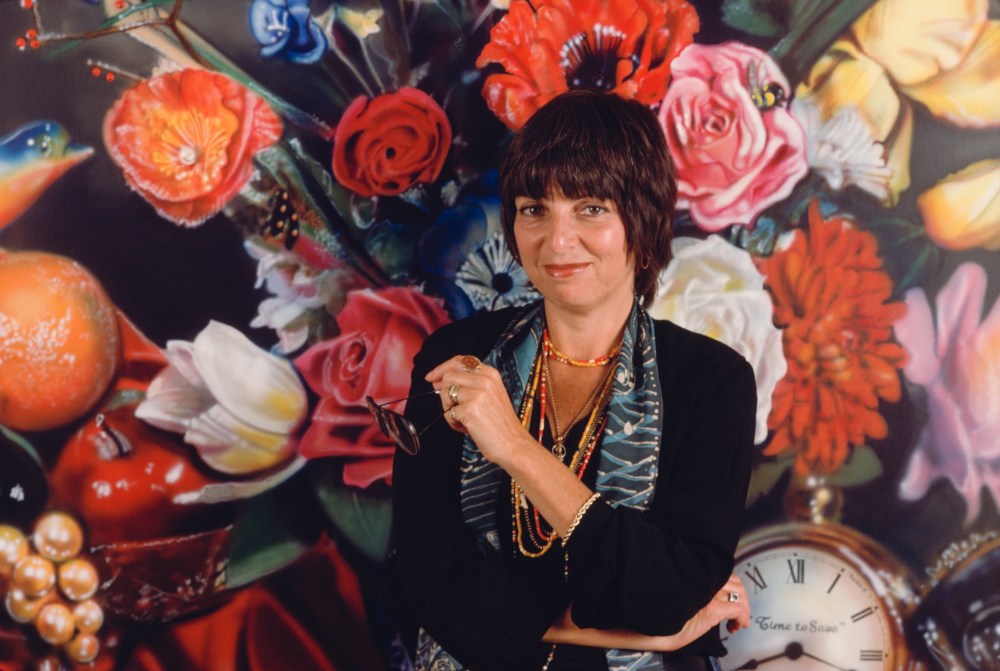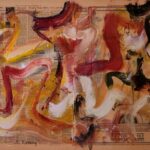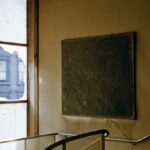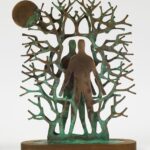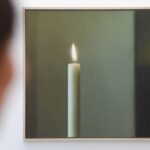Pathbreaking artist Audrey Flack, who pioneered Photorealism before turning to massive bronze sculptures monumentalizing women, died of an aortic dissection on June 28 in Southampton, New York. She was ninety-three. One of the first artists to use a photo as the prototype for a painting—her 1964 Kennedy Motorcade is arguably the first Photorealistic work ever made—she became known for rich, vibrant canvases overflowing with objects such as lipsticks, beads, and movie-star photos, whose femininity stood in stark contrast to the masculine figures and cars depicted by her male counterparts such as Chuck Close and Robert Bechtle. Flack was the first Photorealistic artist to see her work acquired by New York’s Museum of Modern Art, in 1966. As well, she was one of the first women artists to appear in Janson’s History of Art, alongside Mary Cassatt, whose inclusion she lobbied for. “Audrey Flack’s contribution to the history of art cannot be overstated,” gallerist Hollis Taggart told Art and Object this past March. “Audrey has consistently been at the forefront of challenging the artistic trends of her time.”
References: this article is based on content originally published by News Desk on Artforum. You can read the full article here.
Audrey Flack was born in Brighton Beach, Brooklyn, on May 30, 1931, to Jewish parents who had immigrated from Eastern Europe. Her father was a garment worker, and her mother struggled with a gambling addiction. Raised in Manhattan’s Washington Heights, Flack was interested in art from the age of five, when a teacher charged her class with making dioramas. After attending the High School of Music & Art, she earned a graduate certificate in fine arts from Cooper Union. Recruited on a scholarship by Josef Albers to the fine arts program at Yale University, she earned her BFA there before returning to New York to study under Robert Beverly Hale at the Art Students League.
References: this article is based on content originally published by News Desk on Artforum. You can read the full article here.
Flack spent the later part of the 1950s and early 1960s embroiled in the Abstract Expressionist scene then dominant in the city, working in the AbEx mode herself and mixing with artists such as Willem de Kooning, Franz Kline, and Jackson Pollock. The famous drip artist would drunkenly proposition her at the Cedar Tavern, a Greenwich Village hangout favored by downtown artists. The pass typified the sexism then rampant in the art world, where Flack struggled to be taken seriously by her compatriots and by critics.
References: this article is based on content originally published by News Desk on Artforum. You can read the full article here.
In 1964, married to an abusive husband and the mother of two small daughters, one autistic and nonverbal and the other suffering from asthma, Flack like the rest of the world was riveted by the 1963 assassination of President John F. Kennedy and painted Kennedy Motorcade from a documentary photograph. “I never worked from life again,” she told Robert Morgan in a 2009 oral history interview for the Smithsonian Archives of American Art. Though Flack, who always maintained that her particular brand of Photorealism was strongly influenced not just by Abstract Expressionism but by Cubism, continued to paint from news photos, she soon began working from her own pictures, which she developed in her bathroom.
References: this article is based on content originally published by News Desk on Artforum. You can read the full article here.
Drawn to symbolism, which she viewed as universal, and to the cornucopian arrays typical of the dioramas that had caught her attention as a child, she began cramming her canvases with items that complemented and contrasted with one another in a pleasing, almost luxuriant manner: A 1975–76 work Queen, for example, juxtaposes the titular chess piece alongside a queen of hearts playing card; an extravagantly lush rose; a green-faced pocket watch; an open photo locket showing two smiling women, one young, one old; and a tantalizing jumble of jewel-toned makeup jars. Her “Vanitas” series of 1976–78 is similarly Baroque, its assemblages of skulls, candles, portraits, hourglasses, and fruits conjuring the fleetingness of mortality and the inevitability of decay. Not all her works depict such troves: Intricately frosted cakes appear singly, as do architectural wonders, such as the Leaning Tower of Pisa or the Siena Cathedral, while still others are portraits, of relatives, religious figures, or families.
References: this article is based on content originally published by News Desk on Artforum. You can read the full article here.
In the 1980s, now long happily remarried but having endured a bout with depression, she turned to sculpture, much of it monumental in size, and much of it heroizing women. Among the public commissions she received during this phase of her career were the 1990-91 Monumental Gateway to the City of Rock Hill (also known as Civitas) in South Carolina, comprising four twenty-foot high bronze figures on granite pedestals; Beloved Woman of Justice, 2000, a massive bronze bust occupying the courtyard of the Howard H. Baker Jr. US Courthouse in Knoxville, Tennessee; and Veritas et Justitia, 2007, a fifteen-foot high figure of Justice looming before the Thirteenth Judicial Courthouse in Tampa.
References: this article is based on content originally published by News Desk on Artforum. You can read the full article here.
In recent years, Flack returned to Photorealism, this time working in a vein she called “Post-Pop Baroque,” placing superhero comic art and anime cheek-by-jowl with historic illustrations. An exhibition of her work in this self-styled genre is set to open at the Parrish Museum of Art in Waterville, New York, this fall.
References: this article is based on content originally published by News Desk on Artforum. You can read the full article here.
Flack’s memoir, With Darkness Came Stars, arrived earlier this year. She additionally authored several books, among them On Painting (1986), The Daily Muse (1989), and Art & Soul: Notes on Creating (1991). Besides remaining in MoMA’s collection, her work is held by art institutions including the Allen Memorial Art Museum, Oberlin, Ohio; the Butler Institute of American Art, Youngstown, Ohio; the Metropolitan Museum of Art, the Solomon R. Guggenheim Museum, and the Whitney Museum of American Art, all in New York; the Pennsylvania Academy of the Fine Arts, Philadelphia; the National Museum of Women in the Arts, Washington, DC; and the National Gallery of Australia, Parkes.
References: this article is based on content originally published by News Desk on Artforum. You can read the full article here.
“When you’re in the studio painting, there are a lot of people in there with you,” she wrote in Art & Soul. “Your teachers, friends, painters from history, critics . . . and one by one, if you’re really painting, they walk out. And if you’re really painting,” she concluded, “you walk out.”
References: this article is based on content originally published by News Desk on Artforum. You can read the full article here.
